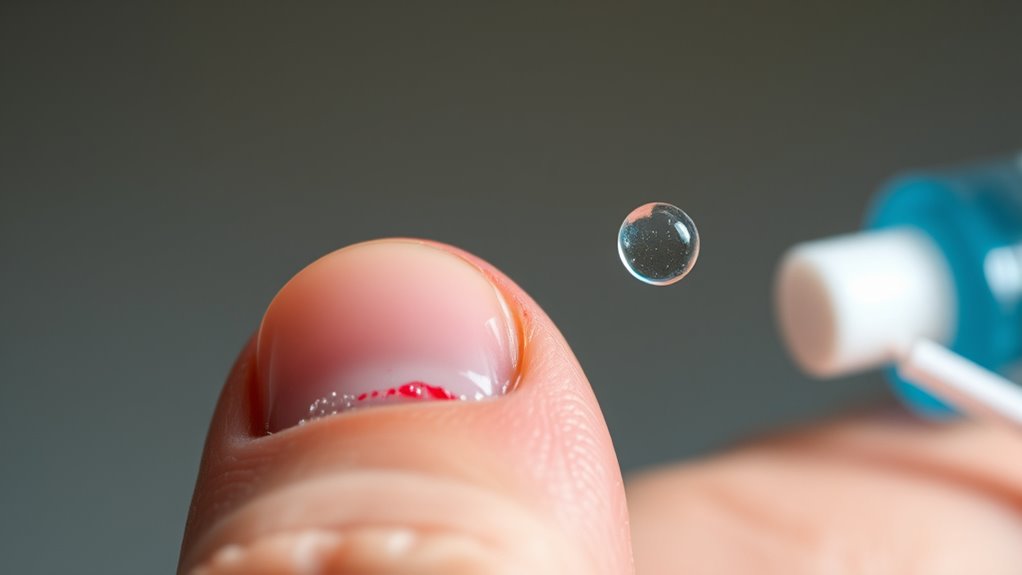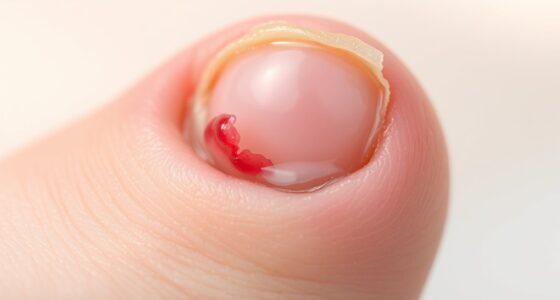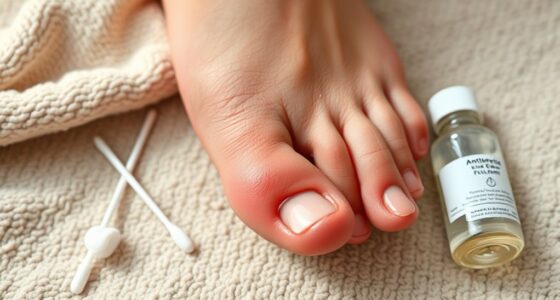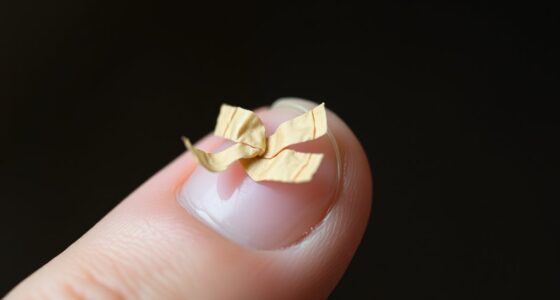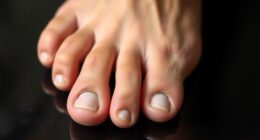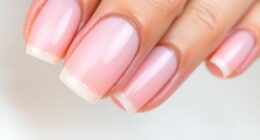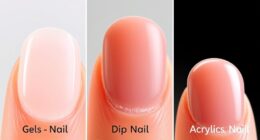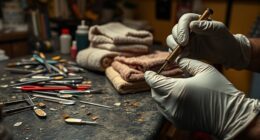If you cut your cuticle, start by gently washing the area with warm water and mild soap to keep it clean. Pat it dry carefully and apply a natural antiseptic like honey or diluted tea tree oil to prevent infection. Cover the injury with a sterile bandage and change it daily or when it gets dirty. Keep the wound moist with petroleum jelly or antibiotic ointment. For more tips on healing fast and avoiding issues, keep exploring with us.
Key Takeaways
- Gently clean the cuticle with warm water and mild soap, then pat dry to prevent infection.
- Apply honey or diluted tea tree oil as a natural antiseptic to promote healing.
- Cover the area with a sterile bandage and change it daily or when dirty to keep it clean.
- Watch for signs of infection like redness, swelling, or pus; seek medical help if symptoms worsen.
- Keep the cuticle moisturized with oils or ointments and avoid picking or trimming until healed.

A cuticle injury can be uncomfortable and may lead to infection if not properly treated. When you accidentally nick or tear your cuticle, it’s important to act quickly to protect your nail health and prevent complications. The first step is to clean the area gently but thoroughly. Use warm water and mild soap to wash away dirt and bacteria, reducing the risk of infection. Pat the area dry with a clean towel—avoid rubbing, as this can irritate the wound further. Once clean, consider applying a natural antiseptic. Many people find that home remedies like honey or tea tree oil can help. Honey has natural antibacterial properties, making it an effective tool in preventing infection and promoting healing. Use a small amount of raw honey on the injured cuticle, and cover it with a sterile bandage. Tea tree oil, diluted with a carrier oil such as coconut or olive oil, can also be applied to reduce bacteria and soothe the area. Just remember to patch-test these remedies first to ensure you don’t react adversely. Keeping the wound moist is essential for nail health. Applying a thin layer of petroleum jelly or an antibiotic ointment helps keep the cuticle hydrated and protected from dirt and germs. This creates an environment conducive to faster healing and reduces the risk of scarring. Cover the injury with a sterile bandage or a small piece of gauze, especially if you’re doing chores or washing your hands frequently. Change the dressing daily or whenever it gets wet or dirty to maintain cleanliness. Avoid biting or picking at your cuticle, as this can introduce bacteria and worsen the injury. Give your body time to heal naturally, and don’t rush to trim or remove the damaged cuticle prematurely. If the injury is minor, these simple home remedies can be highly effective in promoting healing and maintaining nail health. However, if you notice increased redness, swelling, pus, or persistent pain, seek medical attention promptly. These signs could indicate an infection that needs professional treatment. Proper care and attention to your injured cuticle will ensure it heals properly, minimizing discomfort and preserving the beauty and strength of your nails. Additionally, maintaining overall nail health by using nourishing cuticle oils or creams regularly can help prevent future injuries and keep your cuticles healthy.
Frequently Asked Questions
Can I Still Use Nail Polish on a Cuticle Injury?
You might wonder if you can still use nail polish on a cuticle damage. It’s best to avoid applying nail polish directly on a fresh cut or injury, as it can irritate the area or trap bacteria, delaying healing. Wait until the cuticle damage has fully healed. If you must, use a gentle, non-toxic polish and guarantee the skin is completely healed to prevent infection or further damage.
How Long Does It Take for a Cuticle Cut to Heal?
Think of your cuticle as a tiny fortress wall. It typically takes about 5 to 10 days for a cuticle repair to complete, depending on the depth of the cut and your body’s healing timeline. During this period, your body works like a skilled builder, gradually mending the damage. To support healing, keep the area clean, moisturized, and avoid harsh chemicals until fully healed.
Is It Safe to DIY a Cuticle Injury at Home?
It’s generally safe to try home remedies for small cuticle injuries if you keep the area clean and avoid infection. Use antibacterial ointments and keep it moisturized. However, for deeper or more painful cuts, it’s best to seek professional treatment to prevent complications. DIY care can be effective, but don’t hesitate to visit a professional if your injury doesn’t improve or shows signs of infection.
When Should I See a Doctor for a Cuticle Cut?
Did you know that about 3% of nail injuries lead to infections requiring medical care? You should see a doctor for a professional assessment if your cuticle cut shows signs of infection like increased redness, swelling, pus, or if it doesn’t heal within a few days. Also, seek help immediately if you experience severe pain, bleeding that won’t stop, or if you notice spreading redness. Don’t ignore these warning signs.
Are There Specific Products Recommended for Cuticle Injuries?
For cuticle injuries, you should look for products that promote cuticle repair and protect the wound. Wound ointments like petroleum jelly or antibiotic creams help keep the area moist and prevent infection. Applying a nourishing cuticle oil can also support healing. Be sure to clean the cut gently first, then use these products regularly. If the injury worsens or shows signs of infection, consider seeing a healthcare professional.
Conclusion
Now that you’ve nursed that tiny cut, remember, a small injury isn’t just a minor mishap — it’s a wake-up call from your body shouting, “Handle me with care!” Treat every cut like a precious secret, because ignoring it could turn a tiny oops into a giant disaster. So, be gentle, stay vigilant, and give your nails the love they deserve. After all, a healthy cuticle is the gateway to flawless, fearless beauty!
